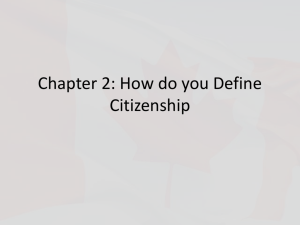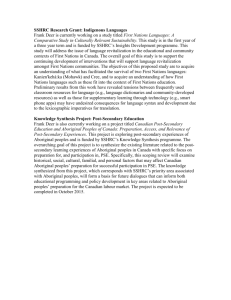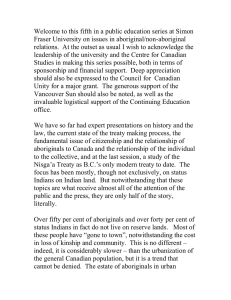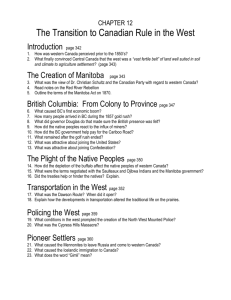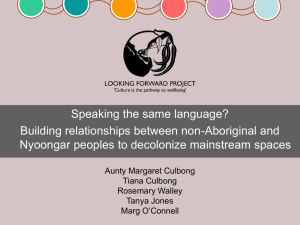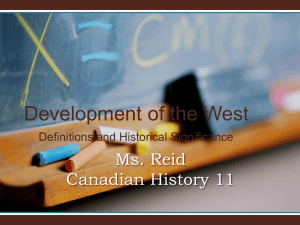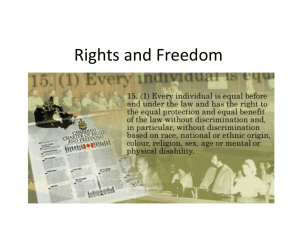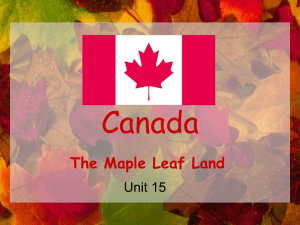Study Guide Answers unit 10
advertisement
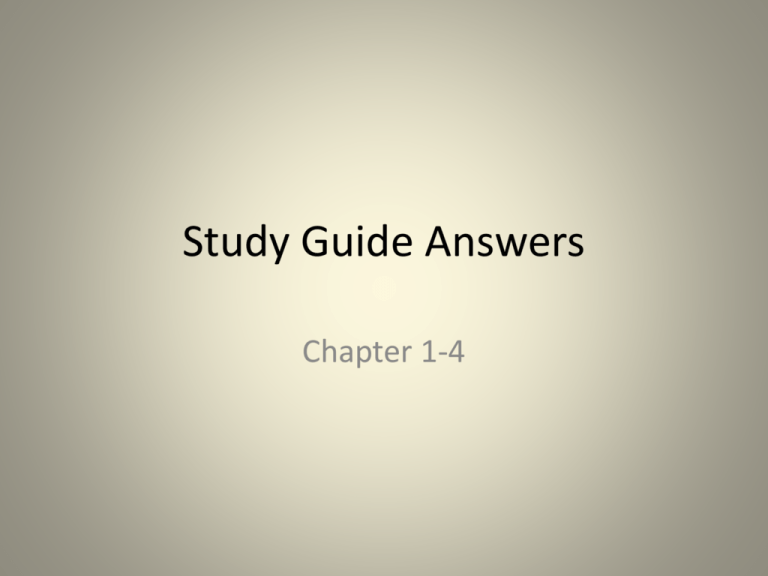
Study Guide Answers Chapter 1-4 – Bilingualism • The Policy of having two official languages – Name the 3 groups of aboriginals • Native Americans, Inuit, Metis – Assimilation • The forced absorbing of another cultural group into our own— undermining their language, religion, and other cultural traits. – Pluralism • A policy of respecting and promoting the differences between groups in Canada’s population. – British North America Act • Signed in 1867—unifys Britain’s North American colonies into what would become Canada – Describe an important instance of assimilation in Canada’s history that concerns the aboriginals • Residential Schools – What is citizenship and why is it important to Canada? • Citizenship is a membership in a group or nation where you receive all the rights the state supplies, but also must carry out the responsibilities and duties that go with them. It is important because it creates a community where everyone does their part so everyone can enjoy the benefits of the community. – What is Immigration and why is it important for Canada? • Immigration is when people move from somewhere else to Canada. It is important because our birth rates are declining and because we value diversity as a nation. – What was the Indian Act of 1876 and what did it do? • It was an act of parliament that banned ancient native cultural practices. It was an effort to assimilate the native population. – What do we mean by Canada’s Northern Sovereignty—and how can Canada protect this? Why is it important? • Canada’s control over its northern territories. Canada can protect this by moving people north, expanding its military and civilian presence. It is important because of how many resources are in that region and for Canada’s identity as a northern nation. – What kind (race/ethnicity) of people did Canada used to only want? • White people—Ukrainians, Europeans, Americans – What was the “Head Tax”? • A tax on every Chinese person who entered the country. – Before the idea of Citizenship was created in Canada people were simply referred to as... • Subjects of the British Empire – Name at least 2 criteria for Canadian Citizenship • 18 years old, permanent resident, lived in Canada for 3 of the last 4 years, pass the test – Name 2 celebrations of Diversity that occur in Canada • Human Rights Day, National Aboriginal Day, Black History Month, Asian Heritage Month – If you have the right to a fair trial and a right to not be searched arbitrarily you have the responsibility to... • Obey the Law – If you have the right to express yourself you have the responsibility to... • Respect the opinions of others – In order to enjoy the “rights” of a Citizen when Canada was first founded you had to be white, male, and what else...? • A land owner – Aboriginal Peoples have the right to Self-Government. What does this mean? • They get special control over their healthcare, housing, education and many other things – Explain the Canadian Charter of Rights and Freedoms • It is a part of Canada’s constitution, added in 1982, that makes it so that all laws must respect the rights of the individual and the equality of everyone. – Historically, what region was the largest provider of immigrants to Canada? • Europe – What region is currently the largest provider of immigrants to Canada? • Asia – Explain the difference between a Melting Pot and a Salad bowl • A melting pot is when people, with different backgrounds, “melt” together to form a different whole. Salad bowl is when people live in the same place, but still maintain their separate identities. – What are some drawbacks of a “Salad Bowl” society? • Everyone maintaining their own identities can cause divisions between Canada’s peoples—everyone will have their own idea about how best to do things and will not always be able to compromise. – When Manitoba joined confederation it was given several guarantees for its French and Metis peoples. Name some of these. • Language rights (official bilingualism) • Two systems of education • Metis land Rights – Consumerism • Belief that buying things is good for the economy and will make you happy – Canadian Content • Media segments that are Canadian made and representative of Canadian lifestyles and values – Reasonable Limits • Limits to ones rights to keep them from infringing on the rights and freedoms of others. – Mass media • Media that has a very large audience and generally enough influence and power to manipulate it – Disability Rights • Accessibility, equality, non-discrimination, communication • Rights, Responsibilities and Freedoms – What is the definition of a Right? Why is it important? • Something to which an individual is morally or legally entitled. It’s important because it is something an individual needs to live their life comfortably and/or successfully and allows them to remain an individual. – What is the difference between a Right and a Freedom? • A right is something that the government has a responsibility to ensure you have access to it (or that it’s protected). A Freedom is something you have that the government does not need to do anything to provide – Does the Charter of Rights and Freedoms give specific examples of how you can or cannot punish a criminal? If so, how? If not, what does it do instead? • It does not—it provides guidelines that courts can use to decide what is cruel or unusual punishment. – The right to vote is called Franchise, and this has been made available to more and more different types of people. How might this change Canada’s politics? • The interests of these different groups will influence what decisions our government makes— i.e. it will be less likely to only look out for white land holding men. – Why are Equality rights so important? • They remove barriers to success and “level the playing field” for all peoples in Canada. – What is a stereotype and what kinds of problems can this sort of prejudice cause? • A stereotype is when a group has a incomplete image of another group that is not necessarily true. – What is personal identity? • Your family, peers, language, religion, the things you like to watch, and all the things that make you unique as an individual. – What is regional identity? • The climate, people, resources, businesses and industry in the area, sports teams, etc. – Name 5 factors that you could use to identify Winnipeg. • • • • • • Prairie Small City Transportation Diverse Cold Etc – Explain what a trend is and what it can tell us about a people’s identity? • A trend is a general direction of people’s preferences. A trend gives us a view into the interests of a people and, in doing so, what kinds of values they might have. – What is Pop Culture? Why is it important? • Specifically it is Popular culture and it shows us what the needs, desires, and values of the general population are. – What is the largest foreign source of popular culture and mass media in Canada? • The United States – What are we talking about when we talk about “New Media”? • Cell phones, Ipods, Blogging, websites, pod-casts, etc. – Pop Culture is a great way for big businesses to make money. Lately they have been targeting groups aged 14-24. Why is this? • Because they (you) have more access to money that you have in history, are more willing to spend it, and are more impressionable than older adults – Why are aboriginal cultures disappearing in the face of pop culture? • Poor image of aboriginal peoples is presented • Mainstream media generally excludes aboriginal writers, artists, actors and other culturally significant peoples – Name several ways in which Canada’s identity is portrayed on the world stage • Peacekeepers, polite, friendly, welcoming, etc. – Give 2 ways that Canada’s official policy of multiculturalism helps to form Canada’s identity • Forces immigration to be colour blind—thereby allowing different groups into the nation which inevitably influence the greater whole • We celebrate our differences and therefore are seen as a welcoming and inclusive society – How is Francophone identity threatened by mass media? • Being constantly exposed to English media is likely to eventually cause Francophones to increasingly identify with their English counterparts. – What is the difference between protecting and promoting culture? • Protecting it is when you enforce laws to ensure that a certain amount of Canadian content is always on TV. Promoting culture is when you try to convince people that it is worth watching – What is the percentage of television programming that needs to be Canadian Content under the MAPL guidelines? • 60% (or 50% between 6pm and midnight) •

